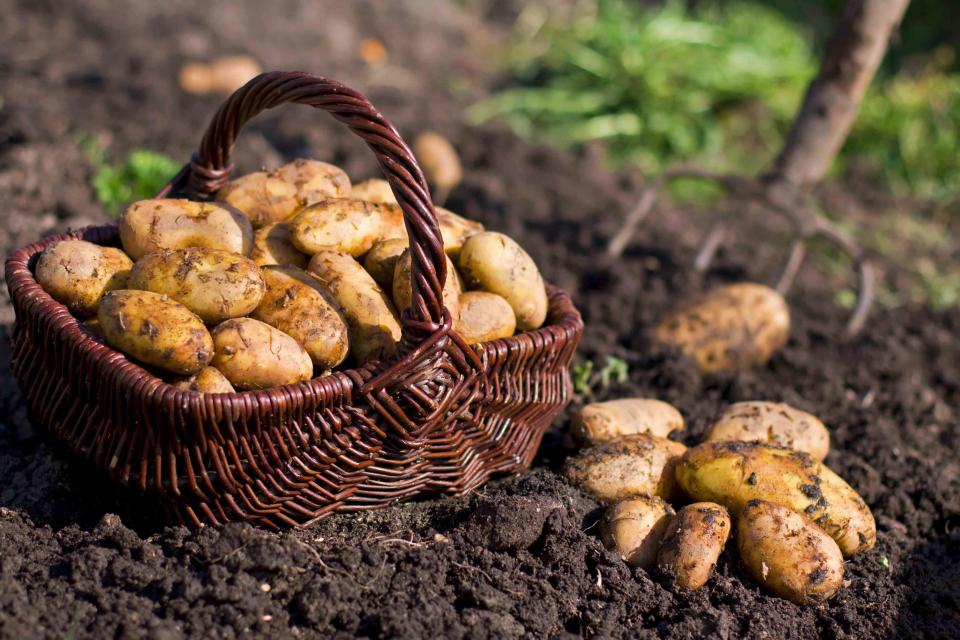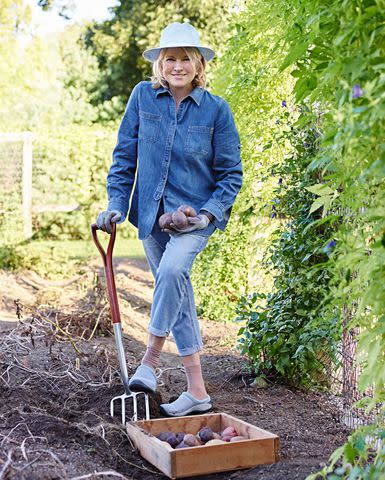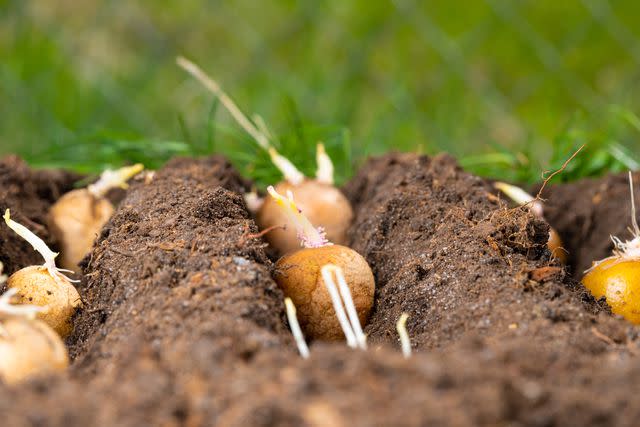How to Grow and Care for Potatoes—Including Martha's Favorite Planting Method
Potatoes are easy to grow for gardeners of all skill levels.

Avalon_Studio / Getty Images
If your home-cooked meals often feature some iteration of the potato—be it mashed, fried, or scalloped—you may want to consider growing the tuber in your garden. Whether you grow a colorful variety like red or purple potatoes or a smaller type like fingerling, the vegetable is very easy to grow for beginner gardeners or experts alike. One thing to consider, though, is that potatoes can take up a lot of room in the garden, so you want to make sure you're planting them in a way that gives the vegetable enough room to grow. Ready to start growing this beloved vegetable? We're sharing expert tips on how to plant, care for, and harvest potatoes.
Meet the Expert
Carrie Spoonemore, co-creator of Park Seed's From Seed to Spoon app
B.J. Thompson of Thompson Potato Farm.
Related: From Lettuce and Beets to Radishes and Peas, These Are the Best Vegetables to Plant in Early Spring
When to Plant Potatoes
Potatoes are generally planted in the early spring when the soil temperature reaches about 45 to 50 degrees Fahrenheit, says Carrie Spoonemore, co-creator of Park Seed's From Seed to Spoon app. The exact time varies depending on your climate and growing zone. "In areas with colder climates, this may be later in the spring and earlier for regions with warmer climates," says Spoonemore.
How to Prepare the Garden for Planting Potatoes
Before planting, you must first prepare the garden bed. Make sure you select an area that gets six to eight hours of full sun and has well-draining, loose soil that's rich in organic material, says Spoonemore. To get the beds ready for planting, break up any surface clumps in the soil and apply fertilizer and a weed deterrent (if necessary). Next, use a cultivator to stir up the land to create loose, fluffy soil that is evenly 6 inches to 8 inches deep, says B.J. Thompson of Thompson Potato Farm.

How to Plant Potatoes
Potatoes are typically grown from pieces of the potato (called seed pieces) or from whole small potatoes, says Spoonemore. If you're growing from seed pieces, cut your potato so that each piece has at least one eye or sprout. An 8 ounce potato for example, is typically cut into four pieces, says Thompson.
Dig furrows so they're 6 inches deep and spaced 2 to 3 feet apart.
Set the seed pieces in the furrows, spacing them 12 inches apart from one another.
Cover the potatoes with 3 to 4 inches of soil.
Water the potatoes well.
Martha's Method for Planting Potatoes
Martha grows more than a dozen organic varieties of potatoes on her farm. She recommends planting the crop in the back or off to the side of your vegetable garden, as potatoes can be unattractive when they begin to mature and ripen. Consider planting them behind beautiful cabbages or broccoli using Martha's method outlined below:
To ensure growth, cut seed potatoes so each piece has at least two eyes. Leave smallest ones whole.
Dip all cut surfaces into ground fir bark (a natural fungicide) let dry a few days. If planted fresh, they can rot.
Dig a furrow roughly 6 inches deep; place potatoes (eyes facing up) about 6 inches apart. Cover with 3 inches of soil. As they grow, backfill to top.
How to Start Potato Seeds Indoors
You can also start potato seeds before spring indoors and transplant them outside. "If starting the seeds indoors, sow the seeds 4 to 6 weeks before the last scheduled spring frost in a shallow seed flat," says Spoonemore. Cover the seeds with 1/16-inch of soilless medium and place them in an area with bright light.
The seeds will germinate in about 10 to 15 days. "They are ready to transplant into small pots when they have at least four true leaves," says Spoonemore. "Then, transition the small pots outdoors so the seedlings can harden off."

OLEKSANDR KOZACHOK / Getty Images
How to Care for Potatoes
Potatoes have relatively straightforward requirements to ensure they grow and thrive in your garden.
Light
Potatoes require adequate sunlight for proper growth. Plant the tuber in an area that receives six to eight hours of full sun for proper growth, says Spoonemore.
Soil
Potatoes prefer soil that is well-draining, such as sandy loam, says Thompson. Additionally, potatoes prefer a pH range of around 5.8 to 6.5, says Spoonemore.
Water
Give potatoes about 1 to 2 inches of water per week for proper growth and root development. "The key is to keep the soil consistently and evenly moist but not waterlogged," says Spoonemore. "In the beginning stages of development, potatoes will require more water; however, once the foliage starts to yellow and die back, reduce the watering frequency to avoid rotting."
Temperature
Potatoes are a cool-season crop and should be planted in soil that is 45 to 55 degrees Fahrenheit. "During the growing stage, the optimal temperature for potatoes is 60 to 70 degrees Fahrenheit," says Spoonemore. "Potatoes are not well-suited to hot temperatures and produce the best yield in regions with cooler nights and mild daytime temperatures."
Fertilizer
You should fertilize potatoes throughout the growing process. "Before planting, incorporate a slow-release, organic fertilizer into the soil," says Spoonemore. "The fertilizer will provide adequate nutrients in the initial growing stages. Once the plant grows to about 6 to 8 inches in height, side-dress the plants with a potassium-rich fertilizer. Once the plant begins to flower, apply fertilizer again."
How to Hill Potatoes
Hilling potatoes, also known as banking potatoes, is an essential part of the growing process. "It’s the process of heaping extra soil on your mounds of potatoes," says Thompson. "We hill the potatoes twice every season." This prevents the tubers from getting exposed to sunlight while they are growing, which will cause them to turn green and become inedible. The first hilling should occur when the plant reaches 6 to 8 inches tall and then again about two to three weeks later.
Types of Potatoes
When growing potatoes, consider these popular varieties.
Russet potatoes: An oblong potato with a darker, thicker skin, russet potatoes are commonly called “baking potatoes," says Thompson. "They are the exact right shape, size, and texture for making fresh-cut fries," she says.
Red potatoes: This variety has thin, smooth skin. "They have a waxy texture that holds shape well when cooked," says Spoonemore.
Yellow potatoes: All varieties of yellow potatoes have a pale skin that is light in texture and yellow inside. "These are a premium potato and they are extremely versatile in the kitchen," says Thompson.
Purple potatoes: This variety has purple skin and flesh. They have a dense and starchy texture when cooked, says Spoonemore, adding that they're a fun variety to grow with children.
When to Harvest Potatoes
Potatoes typically take about 70 to 120 days to mature, but this can depend on the variety and growing conditions. You'll know your potatoes are ready to be harvested once the foliage turns yellow and dies back. "The skin on the potatoes will also set and be thicker and more resistant to damage," says Spoonemore.
How to Harvest Potatoes
To harvest potatoes, gently loosen the soil around the potato, being careful not to damage any tubers. Then, gently dig the potatoes out—Martha uses a sturdy garden fork to do so. Instead of washing your freshly dug harvest, Martha says to remove any soil or dust with a brush to make them last longer in storage. Once harvested and brushed, let your potatoes dry in the sun for a few hours, then cure them in a cool, dark place for about two weeks before storing or using, says Spoonemore.
Read the original article on Martha Stewart.

